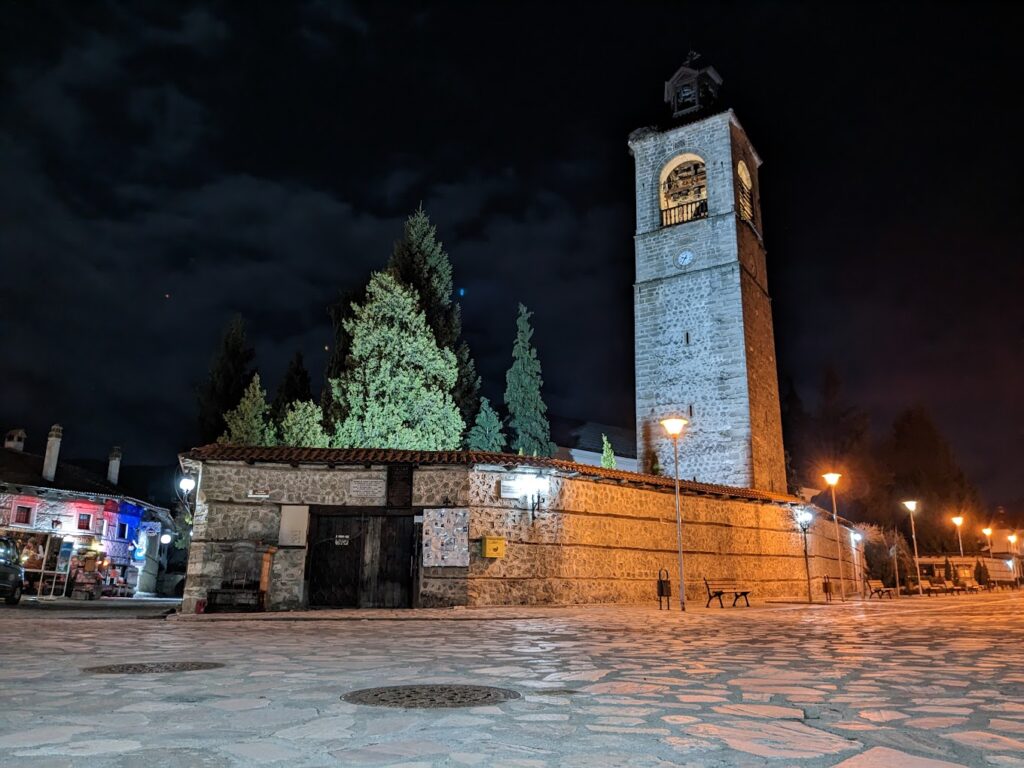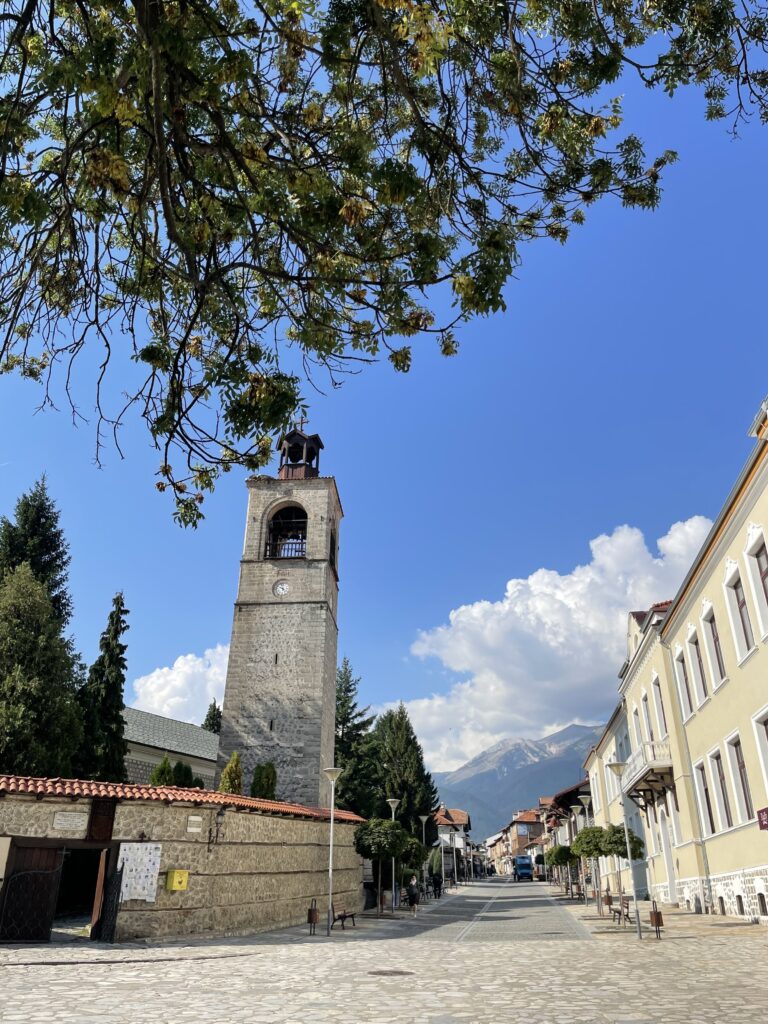The History of Bansko is closely linked to the Saint Trinity Church, one of the most significant landmarks in the region. The church, originally built in 1835, has been beautifully restored with features such as a gilded iconostasis, advanced climate control, and special ventilation to manage candle smoke. These upgrades were made to celebrate its 180th anniversary, thanks to a campaign launched by the civic association “Dedo Lazko” in 2003. This effort reflects the important role the church plays in the history of Bansko.

A Glimpse into the History of Bansko Through Saint Trinity Church
The story of the Saint Trinity Church begins around 1800, a crucial time in the history of Bansko. The idea for building a grand church was inspired by wealthy merchants who had connections in Vienna and other European cities. This vision quickly gained the support of the entire town, which had a long-standing tradition of spiritual and cultural development. Lazar German, commonly known as Dedo Lazko, became a key figure in the history of Bansko, as he dedicated 25 years of his life to bringing the church to fruition, investing his wealth and leadership into the project.
Turbulent Times in Early 19th Century Bansko
The early 1800s were a turbulent period in the history of Bansko, with the village frequently raided by bandits. Under the leadership of Terzi Nikola, the people of Bansko successfully defended their town in 1810. This defense marked a turning point in the history of Bansko, allowing the residents to refocus their efforts on building a monumental church. The desire for a new place of worship was deeply rooted in the community’s sense of pride, strength, and spiritual growth.
The land for the Saint Trinity Church was donated by Lazar German and Father Nikola Benin, the father of the renowned Bulgarian scholar Neofit Rilski. This marked the beginning of a project that would become one of the most significant cultural and religious landmarks in the history of Bansko.
The Path to Construction: A Defining Moment in the History of Bansko
Securing permission to build the church was no easy feat. Diplomatic missions were sent to Constantinople to seek approval from the Ottoman authorities. A key figure in these negotiations was Marko Teodorovich Vezyuv, who was instrumental in advocating for the church’s construction. The process reflected the strategic and determined efforts that shaped the history of Bansko. After years of waiting, a firman (decree) from the Sultan finally arrived in 1833, granting permission for the church to be built. This moment was a milestone in the history of Bansko, as the community’s long-standing ambition could finally be realized.
Fundraising Campaigns: Community Spirit in the History of Bansko
The construction of Saint Trinity Church wouldn’t have been possible without the collective effort of the entire community. A large fundraising campaign was launched to gather the necessary resources, showcasing the deep communal spirit that defines the history of Bansko. The preserved donor lists include 270 families and 1081 individual names, representing every corner of the town. Interestingly, many locals even donated on behalf of their deceased relatives, adding more names to the list. This fundraising effort highlights the strong bonds within the community and the vital role the church played in the history of Bansko.
A second wave of fundraising began in 1834, during which 70 more families contributed to ensure the completion of the church. This unity and generosity became a defining characteristic of the history of Bansko, setting an example for future generations.
Challenges in Construction: Trials and Triumphs in the History of Bansko
The construction of the church was a major challenge, not just financially, but politically as well. Despite securing permission from the Ottoman authorities, the building process faced several obstacles, including opposition from within the town. Some individuals reported Lazar German to the authorities, accusing him of misappropriating funds. Determined to see the project through, German took out a loan from a local Ottoman noble, Altun Bey, under the pretense of using it for trade, but instead directed the funds towards the church’s construction.
Sadly, this deception cost German his life, as he was arrested and executed by the Ottomans around 1839 or 1840. His ultimate sacrifice, however, became a turning point in the history of Bansko. The church was completed in 1835, and consecrated in 1837, marking a major triumph for the town and cementing its place in the history of Bansko.
Architectural Significance in the History of Bansko
Saint Trinity Church remains an architectural marvel, reflecting the cultural aspirations of Bansko during the 19th century. The three-nave pseudo-basilica structure, with its towering stone walls and intricate woodwork, is an enduring symbol of the town’s resilience and ambition. Standing at 44 meters long and 22 meters wide, the church is one of the largest of its kind in the region, a testament to the bold vision that shaped the history of Bansko.
The walls of the church are made from local stone, with a thickness of 110 cm at the base, supported by pine beams. The ceiling is held up by 12 wooden columns, symbolizing the twelve apostles. This impressive structure, surrounded by a 4-meter-high stone wall, has become one of the most iconic buildings in the history of Bansko.
The Bell Tower: A Symbol in the History of Bansko
In 1865, the bell tower was added to the church, becoming a key feature in the history of Bansko. Designed by Gligor Doyuv, the 30-meter-high tower is home to four bells cast by the Veleganov brothers. The clock mechanism, crafted by Todor Hadjiradov, still functions flawlessly to this day, ringing once every hour and marking time for the entire town.
On special occasions, such as two days after Easter, visitors are allowed to climb to the top of the tower, where they can enjoy a 360-degree view of Bansko and the surrounding mountains. This has made the bell tower a treasured feature in the history of Bansko.

Interior Decorations: Craftsmanship in the History of Bansko
Inside the church, the craftsmanship is equally remarkable. The gilded wood-carved iconostasis, created by Dimitar Molerov, remains one of the finest examples of Bulgarian woodcarving. The wooden ceiling, painted to resemble a starry sky, adds a serene and celestial atmosphere to the space. These elements not only enhance the beauty of the church but also serve as a reminder of the rich artistic traditions that have shaped the history of Bansko.
The interior, which was restored in 2010-2012, has regained its original elegance. The white walls, brightened with natural light, and the vibrant colors of the ceiling create a peaceful environment, perfect for reflection and prayer. This attention to detail has made the church a significant cultural and spiritual center in the history of Bansko.
Restoration and the “Dedo Lazko” Association: Preserving the History of Bansko
In 2003, the “Dedo Lazko” association launched a restoration campaign to bring the church back to its former glory. This project aimed not only to restore the physical structure but also to revitalize the town’s connection to its cultural roots. The association, led by Nikola Yanchovichin, a descendant of the original builders, played a key role in organizing the church’s 180th anniversary celebration in 2015. This initiative underscored the importance of preserving the history of Bansko for future generations.
The restoration efforts have ensured that Saint Trinity Church continues to shine as a symbol of the town’s heritage, resilience, and faith. Today, it remains a central part of the history of Bansko, drawing visitors from around the world to explore its beauty and significance.
For more insightful articles on all things related to Bansko, be sure to visit our blog.





